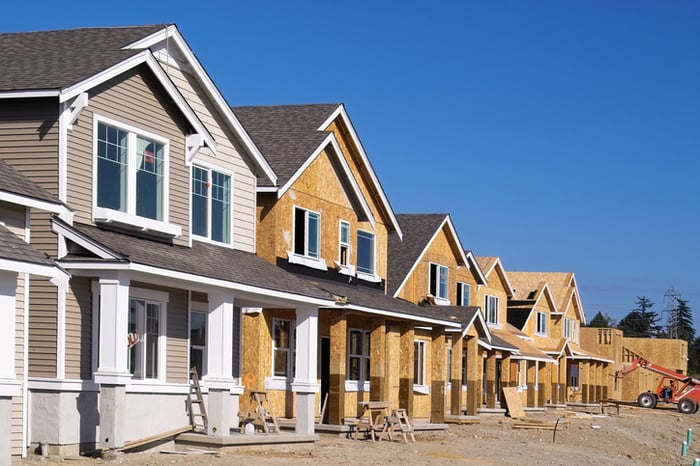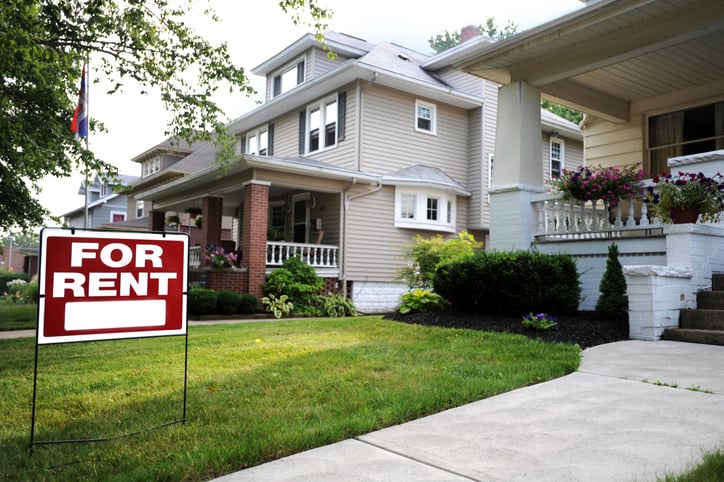
The United States is in the grips of a housing crisis.
Rent and mortgages are skyrocketing, housing supply is at an all time low, and new residential construction is unable to keep pace with record high demand.
The construction industry has a pivotal role to play in solving this crisis, but at the end of the day, we don’t make the rules. The skilled trades may do the heavy lifting but the task of pointing the way toward a more stable and affordable housing landscape ultimately falls to our political leaders.
The question then becomes: What kinds of housing policies should the construction industry be lobbying for?
In this article, we will explore how the American housing crisis affects three segments of the population—unhoused people, tenants, and homebuyers. Then we will outline three policy solutions tailored to each segment that have the potential to upend the housing crisis and transform how the construction industry does business.
The US Housing Crisis in a nutshell
The majority of Americans now spend an average of 37% of their annual income on housing and are just one missed paycheck away from becoming houseless (“houseless” and “unhoused” being the preferred term over “homeless,” according to many modern housing advocates’).
1 year in the US housing crisis (2021 to 2022)
|
Monthly rent
|
15% increase.
|
| Home prices |
20% increase. |
| Inflation |
9.1% increase (40 year high). |
| Hourly wages |
3.6% decrease. |
A person’s housing status can be complicated and change from one day to the next. For our purposes, we’re breaking the spectrum down into three overarching categories: unhoused people, tenants, and homebuyers.
Let’s dive in.
Unhoused people
Rising inflation and housing costs are driving an increase in houselessness across America.
There were more than 580,000 unhoused people at the beginning of 2020, according to a report by the National Alliance to End Homelessness and shelters are reporting a spike in admissions in recent years.
Chronic lack of shelter goes hand in hand with substance abuse and mental illness, creating a vicious cycle that makes it exceedingly difficult for houseless people to find stable housing on their own.
Sadly, most city governments end up criminalizing their unhoused residents, arresting and displacing them rather than providing them with treatment or putting permanent roofs over their heads.
Tenants
For tenants, the housing crisis is the worst it’s been in decades. Landlords are constantly raising rents, which have steadily climbed at an average rate of nearly 9% every year since 1980, outstripping wage growth by miles. The pandemic threw rocket fuel onto the fire, propelling rent increases as high as 40% in some cases. COVID-19 has ebbed and flowed, but rent has shown no sign of receding: According to some estimates, the median monthly rent in the US has increased by 15% from last year to a record high of more than $2,000.
Homebuyers
Homeownership offers one route of escape, but the American Dream isn’t what it used to be.
Since 1965, the price of homes has soared 118%, yet wages have only grown by a meager 15% within that same time frame.
Over the last five years alone, housing prices have shot up a staggering 67%. Once again, COVID-19 seems to have made it worse, spiking the price of homes upward by 20.6% nationwide over the span of a single year (before the pandemic, the price of homes was growing at a rate of less than 4%.)
Meanwhile, interest rates and inflation all continue to climb with no ceiling in sight. First-time homebuyers are thrown into a cut-throat competition not only with each other, but with titanic forces of capital that they stand little to no chance against.
Centi-billion dollar hedge funds and private equity firms like Blackstone and Greystar have been increasingly snatching up real-estate across the US, transforming single-family homes and multi-family residential buildings into high-priced rental properties.
According to one estimate, about 2.5 million first-time homebuyers will be priced out of the market this year by investment firms that are able to outbid them by massive margins.
3 Policy Solutions to the Housing Crisis
Thankfully, there are plenty of tried-and-true ideas out there for how to ease the housing crisis for homebuyers, tenants, and unhoused people alike.
Let’s take a closer look at three of the most transformative housing solutions that are all too often left on the table.
1.) Community land trusts

For homebuyers, one of the most revolutionary solutions to the housing crisis is what’s called a community land trust.
What is a community land trust?
A community land trust (CLT) is a housing tool that empowers people to collectively purchase and own land for the express purpose of providing permanently affordable homes in their communities.
There’s a lot to unpack there, so let’s break down how a typical community land trust works:
- CLTs remove land from the housing market: Under a CLT, the community purchases land–often in blighted or underused areas–and maintains collective ownership over it in perpetuity in order to shelter homeowners from market downturns and maintain control over the price of housing.
- The CLT residents are in charge: CLTs are often managed by democratically run non-profit organizations that are governed in part by the people who live within them.
- Occupants rent the land but own their homes: In a CLT, occupants and their descendants own their homes but rent the land from the CLT in long term “ground leases” of up to 99 years for a small monthly fee.
- Homes are significantly cheaper in a CLT: Housing prices are kept low in CLTs in part because the cost of the land isn’t factored into the housing sale. For example, the Houston Community Land Trust offers three-bedroom homes for as little as $75,000. To sweeten the pot, it also offers up to $150,000 in housing assistance grants to qualified homebuyers.
- Homes must be owner-occupied: Renting, subletting, or “flipping” homes within a CLT is prohibited so as to keep homes from being treated strictly as money-making ventures.
- Homes in a CLT are kept permanently affordable: To ensure long-term affordability, many CLTs use “resale formulas” to limit sales prices and regulate the amount of equity that homeowners earn.
What are the benefits of community land trusts?
Here are just a few of the benefits of community land trusts:
- Community land trusts create opportunities for home-ownership: In a CLT, high quality homes that would otherwise be unaffordable are suddenly within reach
- Community land trusts help low-income households build generational wealth: Home ownership helps families generate wealth from one generation to the next. The high cost of living often forecloses on this possibility, but under a CLT, families can afford a foundation upon which to build an economically prosperous future.
- Community land trusts build communities: Under the current model, people experiencing housing precarity are often displaced from their homes or are forced to hop from one rental property to the next. A CLT on the other hand empowers people to put down roots in their community. People take pride in their homes, neighborhoods, and societies when they feel the sense of ownership and belonging that a CLT can provide.
The construction industry stands to benefit from successful CLTs, as they drive revitalization and demand for new affordable housing stock.
How common are community land trusts?
Community land trusts are still fairly rare, but they are gaining in popularity. As of 2021, there are more than 260 community land trusts in the US, according to the University of Wisconsin's Population Health Institute.
The world’s first community land trust sprang out of the southern United States during the Civil Rights movement. Founded in 1969 in Albany, Georgia, the New Communities land trust was designed to provide affordable housing for low-income African American families.
The largest community land trust in the US is the Champlain Housing Trust in Burlington, Vermont. Originally founded in 1984 under the mayoral administration of Bernie Sanders, the Champlain Housing Trust currently boasts 642 affordable homes, 2,489 rentals units, and nearly $200 million in assets.
2.) Rent control

What if there was a way to keep the price of rent from spinning out of control?
What is rent control?
Rent control refers to any set of rules, laws, or regulations aimed at limiting how much landlords can charge their tenants. The goal of rent control policies is to ensure that rental housing stock in a given area remains affordable.
Rent control can happen on any scale, from the national all the way down to the local levels. There is currently no federal rent control legislation in place, although various states and cities have opted to implement rent control laws of their own.
The details of rent control laws vary from place to place. For example: Oregon, which became the first state to pass a comprehensive rent control law in 2019, caps rent increases across the entire state at 7% plus inflation within a 12 month period.
How common is rent control?
Rent control is nothing new. The shortage of resources during World War 1 contributed to a massive decline in housing and a spike in rental prices, which in turn led to rent strikes in cities like New York, where some of the nation’s first rent control laws were put on the books in the 1920s.
The idea hasn’t exactly taken the country by storm since then. Roughly 182 municipalities and a total of three states–California and Orgegon, including the District of Columbia–have passed statewide rent control legislation while lawmakers in 37 other states have banned it outright.
What are the benefits of rent control?
Each of the ideas in this article is the subject of spirited debate, but few are as divisive as rent control.
Proponents often enumerate the following benefits:
- Rent control reduces rent: Rent control laws can place caps on rent that make leases more affordable for tenants.
- Rent control reduces evictions: If rent is more affordable, then tenants are more likely to be able to continue paying it, and therefore less likely to be evicted.
- Rent control builds socially cohesive communities: When tenants can afford to pay rent, they are able to stay within and contribute to their communities.
Meanwhile, critics of rent control argue that it can actually bring about the opposite of its intended effects. Many detractors are landlords and real-estate developers who are wary of any policy that restricts how much profit they can extract from their properties.
It's a bit of a mixed bag from the construction industry’s perspective. Some experts warn that rent control dampens new construction while others have concluded that it has virtually no effect on construction at all.
Where you fall on the issue depends largely on whose angle you view it from: the landlords or their tenants. For its part, a 2019 analysis of rent control by the Urban Institute concluded the following:
“If rent control is judged on its ability to promote stability for people in rent-controlled units, evidence has generally found it to be successful. Research on rent control’s effects on the broader housing market (whether on rents, construction, or conversion) have yielded mixed results.”
The conventional wisdom among most economists is that rent control is a bad thing, but the extreme economic imbalance of the housing crisis may have reached a point in recent years that demands a shift in perspective.
In some places, that shift is already underway. In cities like New York and San Francisco, where housing prices have vastly outstripped wage growth, lawmakers have long embraced rent control as a policy solution to help keep tenants above water. A growing list of other cities and states have taken notice and are beginning to consider rent control policies of their own.
3.) Housing First

There are hundreds of thousands of people in the US who have no shelter at all. When it comes to helping them, one of the most effective and straightforward solutions is to simply giving them a place to live.
What is Housing First?
Housing First–otherwise known as “permanent supportive housing” or “rapid re-housing”–is a term that refers to any program or policy that provides unhoused persons with unconditional, permanent, and secure housing.
Many cities offer houseless shelters, but these are temporary and often come with strings attached.
Housing First advocates argue that permanent housing is a fundamental need that must be addressed before any further quality of life improvements such as psychiatric help, substance abuse treatment, or vocational training can be effectively delivered to unhoused individuals.
It’s easier for unhoused people to get back on their feet, proponents believe, when housing is taken care of first.
What are the benefits of Housing First?
Several research studies have identified some key benefits to the Housing First approach:
- Housing First is an effective solution to homelessness: A 2021 study showed that Housing First programs decrease homelessness by 88% and improve housing stability by 41%.
- Housing First is a good investment: Housing First reduces hospital visits and overall spending on unhoused individuals, saving the public between $944 and $29,388 per unhoused person who is given a place to live.
From the construction industry’s perspective, giving away homes for free might sound some alarms at first. However, Housing First programs are paid for by state and municipal governments. The adjustment to this new paradigm, if it were widely embraced, would likely be minimal: After all, construction companies enter into contracts with publicly funded entities all the time. Indeed, Housing First could drive a construction boom if cities opt to build brand new residential structures to house their unhoused residents.
And from the city’s perspective: Housing First can still be effectively implemented even if new construction isn’t in the cards. According to a recent analysis by Lending Tree, there are about 16 million vacant homes in the US. What our political leaders do with those empty homes is a matter of choice.
How common are Housing First programs?
Though there is no nationwide Housing First program, the US Department of Housing and Urban Development (HUD) and the US Interagency Council on Homelessness (USICH) have both officially cited Housing First as a best practice for providing shelter to people in need.
In the US, Utah has made great strides with its own Housing First program. By giving homes away as part of a multi-pronged approach, the state was able to reduce its chronic unhoused population by a staggering 91% in 2015.
Declarations of victory over houselessnes have been premature, but Utah remains a prime example of the success that governments can have when they choose to give permanent shelter to those who need it most.
Bottom Line
Housing First, rent control, and community land trusts have the potential to positively transform the housing landscape in America.
Our culture tends to view housing as a commodity instead of an essential human right. While not perfect, the policies discussed in this article nudge us toward a reversal of that polarity, hinting at a world where housing is far less precarious.
The housing crisis is a complicated web. To disentangle it, stakeholders across the board will have to deploy a diverse array of strategies and tactics. Those of us in the business of building the homes of tomorrow are uniquely positioned to influence what direction our society moves in by lobbying on behalf of sensible reforms that make housing more affordable and widely available to everyone.